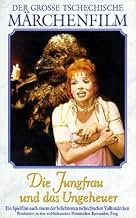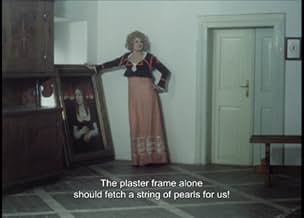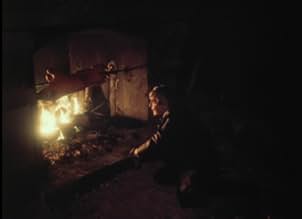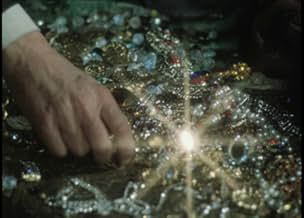Panna a netvor
- 1978
- 1h 31min
CALIFICACIÓN DE IMDb
7.5/10
2.1 k
TU CALIFICACIÓN
En esta versión gótica del clásico cuento de hadas, una misteriosa bestia alada mantiene prisionera a la hija menor de un comerciante.En esta versión gótica del clásico cuento de hadas, una misteriosa bestia alada mantiene prisionera a la hija menor de un comerciante.En esta versión gótica del clásico cuento de hadas, una misteriosa bestia alada mantiene prisionera a la hija menor de un comerciante.
- Dirección
- Guionistas
- Elenco
- Premios
- 2 premios ganados y 1 nominación en total
Opiniones destacadas
This is such a strange film. Nominally a Beauty and the Beast rendition (the title translates to Virgin and the Monster), it is introspective wandering through dreams. It is both rich in what we see of dreams and silly. The filmmaker (Juraj Herz, also responsible for Cremator) juggles various moods, sombre elegy to medieval fairytale.
As you watch it, it may strike you as both obvious and muddled, obvious because its fantasy is of the schematic sort, with onedimensional characters like the 'kindly father', 'innocent maiden', 'petty step- sisters'. The monster looks silly. So it may seem like it's not worth the effort of bridging the distance to what is going on behind the simplistic surface.
However, scrap all that and this may get to you. It got to me, at least for a while. It isn't about just the Gothic mood. Its appeal is a series of interleavened dreams, but you aren't always sure who is dreaming, if sometimes more than one dreamer, and when one bleeds into the next, so you drift with it.
Consider this as the story. A rich merchant father has to marry off his daughter in a marriage of convenience, the anxiety this causes to both is at the root of the film. It isn't in the film as such, but you will get something of the sort if you conflate the different threads.
From the father's perspective, this means sending off his daughter to live with a 'monster' in his dark lair, from her perspective, it means going to live alone with a stranger, her fate sealed. This translates in several scenes of hallucination, all of it wonderfully visual—the ominous destruction of the merchant wares in the woods, the father's deal with the monster for the girl, the girl's gilded dream of a handsome prince (inside a coffin) and half-frightful, half-anticipatory wandering in the mansion hearing just his voice.
The plucking of roses as loss of purity is a central motif.
It's silly again as we shift to the monster's soliloquies of what it means to be human, but that is because we don't have a surrogate for him in the level of reality, he solely exists inside the fantasy as the abstract ogre made human by her touch. The Czech often favor a juvenile theatricality.
But there's something else that is cool. Now so far all points to constructed realities, dreams as tailored emotional space. The girl wonders if she's not imagining everything, in one scene she visits as ghostly observer her sisters' wedding, no one can see her.
Here's how the filmmaker adds layers to the monster. He has conflicting sides to him, two voices that ponder on whether to kill or spare the girl. The 'evil' voice is disembodied, in his mind. This 'evil' narrator is coming from the camera, you'll notice this is linked with subjective shots of the monster as it kills the wench in the woods, roams with a candelabra and early on 'stages' the frightful visit of the father. It's the filmmaker's hand (as internal consciousness shaping the story) pushing for horror, very cool to see.
So as with many films of this sort, the film becomes more disposable the more you settle on what the story is supposed to be. It fits somewhere between Lynch, Hourglass Sanatorium for nested doll-worlds, Jean Rollin's wandering and Valerie's Week of Wonders.
I listed the films (and makers) in descending order of preference, which for me is the order by which, as you peel away layers, you get less and less of what you thought is there, it opens up, instead of a single solid core. Angels dancing instead of a pin's head.
So if you want a cryptic story disguised to mean something, this is cryptic but as with Rollin and Valerie it makes rather simple sense. At the same time, it is dissonant enough once you disengage from story to captivate. I will see if I can track down more from this guy, he may deserve a place in my nightly viewings.
As you watch it, it may strike you as both obvious and muddled, obvious because its fantasy is of the schematic sort, with onedimensional characters like the 'kindly father', 'innocent maiden', 'petty step- sisters'. The monster looks silly. So it may seem like it's not worth the effort of bridging the distance to what is going on behind the simplistic surface.
However, scrap all that and this may get to you. It got to me, at least for a while. It isn't about just the Gothic mood. Its appeal is a series of interleavened dreams, but you aren't always sure who is dreaming, if sometimes more than one dreamer, and when one bleeds into the next, so you drift with it.
Consider this as the story. A rich merchant father has to marry off his daughter in a marriage of convenience, the anxiety this causes to both is at the root of the film. It isn't in the film as such, but you will get something of the sort if you conflate the different threads.
From the father's perspective, this means sending off his daughter to live with a 'monster' in his dark lair, from her perspective, it means going to live alone with a stranger, her fate sealed. This translates in several scenes of hallucination, all of it wonderfully visual—the ominous destruction of the merchant wares in the woods, the father's deal with the monster for the girl, the girl's gilded dream of a handsome prince (inside a coffin) and half-frightful, half-anticipatory wandering in the mansion hearing just his voice.
The plucking of roses as loss of purity is a central motif.
It's silly again as we shift to the monster's soliloquies of what it means to be human, but that is because we don't have a surrogate for him in the level of reality, he solely exists inside the fantasy as the abstract ogre made human by her touch. The Czech often favor a juvenile theatricality.
But there's something else that is cool. Now so far all points to constructed realities, dreams as tailored emotional space. The girl wonders if she's not imagining everything, in one scene she visits as ghostly observer her sisters' wedding, no one can see her.
Here's how the filmmaker adds layers to the monster. He has conflicting sides to him, two voices that ponder on whether to kill or spare the girl. The 'evil' voice is disembodied, in his mind. This 'evil' narrator is coming from the camera, you'll notice this is linked with subjective shots of the monster as it kills the wench in the woods, roams with a candelabra and early on 'stages' the frightful visit of the father. It's the filmmaker's hand (as internal consciousness shaping the story) pushing for horror, very cool to see.
So as with many films of this sort, the film becomes more disposable the more you settle on what the story is supposed to be. It fits somewhere between Lynch, Hourglass Sanatorium for nested doll-worlds, Jean Rollin's wandering and Valerie's Week of Wonders.
I listed the films (and makers) in descending order of preference, which for me is the order by which, as you peel away layers, you get less and less of what you thought is there, it opens up, instead of a single solid core. Angels dancing instead of a pin's head.
So if you want a cryptic story disguised to mean something, this is cryptic but as with Rollin and Valerie it makes rather simple sense. At the same time, it is dissonant enough once you disengage from story to captivate. I will see if I can track down more from this guy, he may deserve a place in my nightly viewings.
9mar9
SBS-TV used to screen this film on an annual basis, but it has been missing in action for some years, which is cause for regret. The title may seem obscure, but a look at the alternative English translations ("Maiden and the Beast" and "Virgin and the Monster") should make this clearer. This is quite simply a wonderful interpretation of the classic fairy tale of Beauty and the Beast, produced and filmed in the then Czechoslovakia. Cinematic gems can be found in what may be thought to be unlikely places, and this film is an example.
Students of cinema may be aware that Cocteau did a version of this story in B&W, and there is of course the more recent and rather tame Disney version. This film is a very different proposition. For a start, it is unsuitable for young children because of some fairly graphic violence, including scenes of animal cruelty. The film-makers seem to strive for realism, particularly the scenes in the village where Beauty (here called Julie) lives, all mud and images of earthy rural life before the Industrial Revolution. But even the magical bits are portrayed realistically. The Beast's castle is maintained by an array of goblin-like servants, who skulk in the shadows of the fireplaces and chandeliers. If I have one complaint about this film, it is that the scenes are sometimes so dark that it is difficult to see what's happening. This does heighten tension, but it can be overdone.
The actors are great, especially the two charismatic leads. The Beast (Vlastimil Harapes) is fashioned more as a great bird of prey than Cocteau's leonine creation, and there is great suspense as he struggles with his inner violent nature (a sinister whispering voice) that is urging him to remain in his beastly form and kill the innocent Julie. Julie (Zdena Studenková) in turn is wonderfully portrayed. We can see why she is so obviously her father's favourite.
Fairy tales are expositions of the human condition, and the Beauty and the Beast story is no different. "Every woman has the power the make the one she loves beautiful". It's a simple theme, but this film explores it beautifully. See it if you can.
Students of cinema may be aware that Cocteau did a version of this story in B&W, and there is of course the more recent and rather tame Disney version. This film is a very different proposition. For a start, it is unsuitable for young children because of some fairly graphic violence, including scenes of animal cruelty. The film-makers seem to strive for realism, particularly the scenes in the village where Beauty (here called Julie) lives, all mud and images of earthy rural life before the Industrial Revolution. But even the magical bits are portrayed realistically. The Beast's castle is maintained by an array of goblin-like servants, who skulk in the shadows of the fireplaces and chandeliers. If I have one complaint about this film, it is that the scenes are sometimes so dark that it is difficult to see what's happening. This does heighten tension, but it can be overdone.
The actors are great, especially the two charismatic leads. The Beast (Vlastimil Harapes) is fashioned more as a great bird of prey than Cocteau's leonine creation, and there is great suspense as he struggles with his inner violent nature (a sinister whispering voice) that is urging him to remain in his beastly form and kill the innocent Julie. Julie (Zdena Studenková) in turn is wonderfully portrayed. We can see why she is so obviously her father's favourite.
Fairy tales are expositions of the human condition, and the Beauty and the Beast story is no different. "Every woman has the power the make the one she loves beautiful". It's a simple theme, but this film explores it beautifully. See it if you can.
10Atulur
Although I doubt that this film was ever on in the U.S., since I live in the country where it was shot, I can warmly recommend it to anyone who loves fairy tales taken in a harsher and darker manner. The atmosphere of the film is gloomy and the camera is very original - we can see the Beast /who has here gruesome bird-like looks/ only in the middle of the film. In the first part of the film we feel his presence only through his eyes. The beginning of the movie has nothing to do with a fairy tale, it is a pure horror - a dark forest, amazing church-pipe tones, chilling to the bone, mist all around and a sudden sound of hoofs getting nearer and nearer... The dark atmosphere of the whole film is weakend by a dream interlude in which the Monster is shown as a normal human being dancing with the heroine in rooms full of glare and light. Fantastic music again. Perfect acting /best Czech actors whatsover, great choreography/,a super setting /a dark palace of the Monster/. The film will give you a totally different approach to the old well known fairy tale.
The honest merchant Otec (Václav Voska) goes bankrupt when he loses the cargo of dowry for the wedding of his ambitious and envious older daughters Málinka (Zuzana Kocúriková) and Gábinka (Jana Brejchová) with decadent earls. His only chance to raise money is selling the painting of his former wife and mother of the sweet and pure youngest daughter Julie (Zdena Studenková). He travels through the Haunted Wood during the night, but his horse dies and he seeks shelter in the derelict castle of the Beast (Vlastimil Harapes). He is well received by his host that buys his painting by a fair price. When he is leaving the castle, he takes a rose for Julie from the Beast's rosebush and his host tells that he must pay with his life for the theft of the rose. He asks for permission to return home to give the jewels for his daughters, but he would return to the castle since he is a man of honor. The Beast accepts and tells that his life would be spared whether one of his daughters agrees to come to the castle. When Julie learns the proposal, she travels to the castle to save the life of her father. She is forbidden by the Beast to look at him, but along the lonely days, she falls in love with his voice and kindness.
"Panna a netvor" (1978), a.k.a. "Beauty and the Beast", is a dark version from Czechoslovakia of the classic fairy tale. The plot is flawed, since the curse and the magic of the beast are not explained, and ambiguous, since the conclusion is not sure that is the reality or the beautiful view of the ugliness of Julie. The performances, lighting and shadows are magnificent. My vote is seven.
Title (Brazil): "A Bela e a Fera" ("The Beauty and the Beast")
"Panna a netvor" (1978), a.k.a. "Beauty and the Beast", is a dark version from Czechoslovakia of the classic fairy tale. The plot is flawed, since the curse and the magic of the beast are not explained, and ambiguous, since the conclusion is not sure that is the reality or the beautiful view of the ugliness of Julie. The performances, lighting and shadows are magnificent. My vote is seven.
Title (Brazil): "A Bela e a Fera" ("The Beauty and the Beast")
We've all heard or seen the classic fairy tale of "Beauty and the Beast" but it's probably fair to say that you've never seen a version as beautifully done as this 1978's Czech adaptation. Absurd you say? Like most people who grew up in the 90's, I was long under the impression that the only film version of "Beauty and the Beast" that counted was Disney's 1991 animated classic. But then I came across this version. Directed by Juraj Herz, it sets the tale in a gloomy world where we met a well to do merchant who's expecting a large shipment of priceless jewels, diamonds, the whole works. But unfortunately for him, they are stolen in route by the dreadful beast that haunts the black forest. Desperate to provide for his three daughters, he sets out to the beast's decrypted mansion to sell a priceless painting of his late wife. At first, everything goes well until he makes the mistake of plucking a rose from the beast's garden. Through some creative camera work, we don't see the beast right away but from the father's reaction know that he is hideous and angry . The beast tells him that if he wants to live, one of his daughters must come on her own free will to be with him forever. Julie, his kindest and most caring daughter, volunteers to sacrifice herself for her father despite not knowing the grisly details. When she first meets the beast, she only knows his voice since he only talks to her from behind. Yet, Julie can't help but feel something tug at her heart and what follows is one of the most dark and surreal love stories ever put to screen.
Let me just state that this is probably not the best version to show little kids due to the fact that it may give them nightmares! The director here was clearly going for a creepy and atmospheric take on the legend with the dark lighting, eerie shooting locations, and winding camera angles from the beast's point of view. In other words, it's what a fairy tale is supposed to be before Hollywood waters it down for kids. Also the music score, with its foreboding organ chimes, goes a long way to establishing suspense and apprehension as well as beauty when that organ switches to piano. As for the beast himself, he manages to be both strange and ugly with his bird/beast hybrid look (Considering the time and country it was made in, the costume and make up is fairly realistic). Since this beast is capable of using magic, he has his own goblin servants, including one who sits in chandelier that moves up and down when it's time to serve drinks. But the movie is more than just a horror picture; it's also a love story, one that is told well by its writing and actors. The filmmakers are able to present the beast as a complicated being who is torn between his new found love for Julie and his inner animal, which is presented in the form of a malicious whisper. Despite being under a lot of make up, Vlastimil Harapes is able to shine through and make you care about his plight. As for Julie, she could not be any more lovelier than in the form of Zdena Studenkova, who cuts a fine figure but more importantly, a beautiful personality for her character. Unlike her materialistic sisters, she has an innocent heart and truly cares for her father's well being, not just his money. But can Julie overcome the beast's hideous face and can the beast repress his animal instinct once and for all so they can live happily ever after? It all leads up to heartfelt conclusion that teaches us it's not what's outside that counts, but what is inside. Sadly (Maybe because it was made behind the iron curtain) the movie does not seem to be all that available. The only place I can recommend would be you tube. As far as finding a DVD, it appears to only be available in Europe. But the you tube version does have English subtitles and is in fair viewing condition. With that said, I urge you to check it out this beautifully dark version of the tale while you still can and remember that a woman makes a man she loves beautiful.
Let me just state that this is probably not the best version to show little kids due to the fact that it may give them nightmares! The director here was clearly going for a creepy and atmospheric take on the legend with the dark lighting, eerie shooting locations, and winding camera angles from the beast's point of view. In other words, it's what a fairy tale is supposed to be before Hollywood waters it down for kids. Also the music score, with its foreboding organ chimes, goes a long way to establishing suspense and apprehension as well as beauty when that organ switches to piano. As for the beast himself, he manages to be both strange and ugly with his bird/beast hybrid look (Considering the time and country it was made in, the costume and make up is fairly realistic). Since this beast is capable of using magic, he has his own goblin servants, including one who sits in chandelier that moves up and down when it's time to serve drinks. But the movie is more than just a horror picture; it's also a love story, one that is told well by its writing and actors. The filmmakers are able to present the beast as a complicated being who is torn between his new found love for Julie and his inner animal, which is presented in the form of a malicious whisper. Despite being under a lot of make up, Vlastimil Harapes is able to shine through and make you care about his plight. As for Julie, she could not be any more lovelier than in the form of Zdena Studenkova, who cuts a fine figure but more importantly, a beautiful personality for her character. Unlike her materialistic sisters, she has an innocent heart and truly cares for her father's well being, not just his money. But can Julie overcome the beast's hideous face and can the beast repress his animal instinct once and for all so they can live happily ever after? It all leads up to heartfelt conclusion that teaches us it's not what's outside that counts, but what is inside. Sadly (Maybe because it was made behind the iron curtain) the movie does not seem to be all that available. The only place I can recommend would be you tube. As far as finding a DVD, it appears to only be available in Europe. But the you tube version does have English subtitles and is in fair viewing condition. With that said, I urge you to check it out this beautifully dark version of the tale while you still can and remember that a woman makes a man she loves beautiful.
¿Sabías que…?
- TriviaThe beast looks like a bird in this version.
- ErroresWhen the father is travelling with the painting, a crow flies out from behind a log. A crew member's hands can be seen throwing the bird upward.
- ConexionesFeatured in Predcasná úmrtí: Bozský skeptik (2001)
Selecciones populares
Inicia sesión para calificar y agrega a la lista de videos para obtener recomendaciones personalizadas
- How long is Beauty and the Beast?Con tecnología de Alexa
Detalles
- Fecha de lanzamiento
- País de origen
- Idioma
- También se conoce como
- Beauty and the Beast
- Productora
- Ver más créditos de la compañía en IMDbPro
Contribuir a esta página
Sugiere una edición o agrega el contenido que falta
































